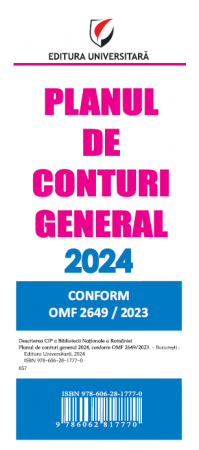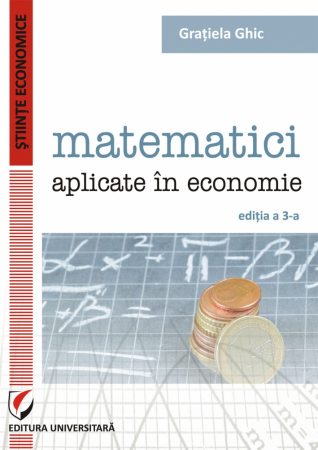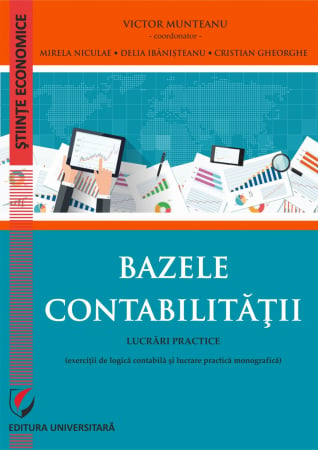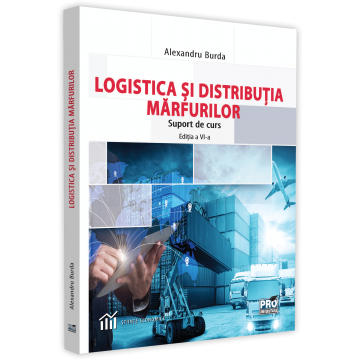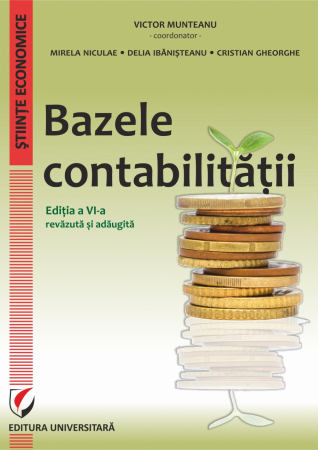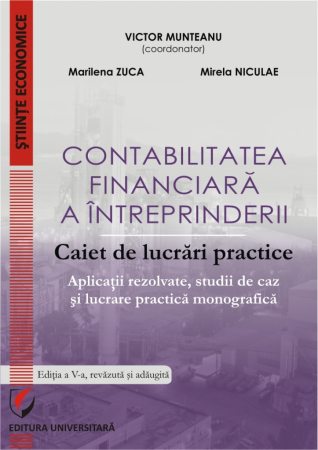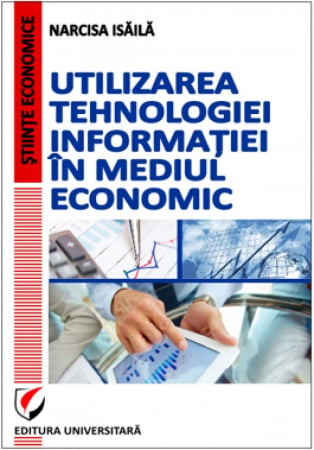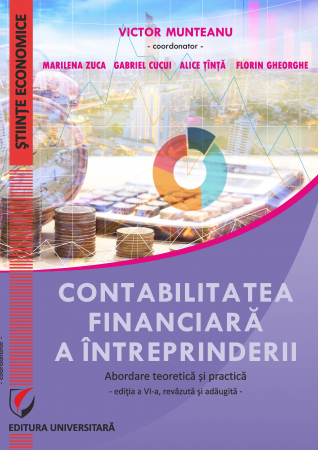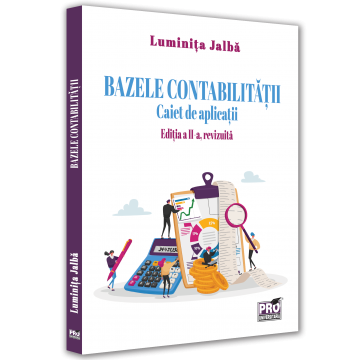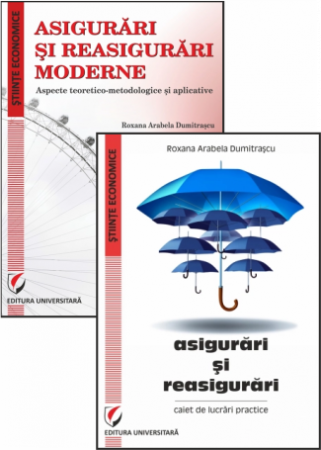Manuscript proposals: [email protected] / 0745 204 115 //// Tracking orders Individuals / Sales: 0745 200 357 / Orders Legal entities: 0721 722 783
Publisher: Editura Universitară
Author: Mariana Iatagan
ISBN: 978-606-591-423-0
DOI: 10.5682/9786065914230
Publisher year: 2012
Edition: I
Pages:
Product Code:
9786065914230
Do you need help?
0745 200 357
- Description
- Download (1)
- Authors
- Content
- More details
- Reviews (0)
In the current context of the knowledge-based society, a country's education system is perhaps more than ever the "key" to its present and future development. Although funding is not exactly the "mother of learning", an efficient, equitable and competitive education system cannot exist without optimal financial support.
Currently, in Romania, the public financial resources allocated to university education, although insufficient, are extremely dispersed and private sources intended for financing higher education are still timidly represented. The insufficiency of resources corroborated with the explosion of the number of students, as well as of the number of educational institutions offers a relatively gloomy image of the Romanian education.
There are in the eight development regions, 49 public universities with over 550 faculties, in which about 900,000 students study. To these institutions are added another 315 faculties of private education. There are areas where we find five public universities within a radius of 300 km, with similar fields of study and where, due to low demand, competition is very low. This begs the question: is there still a desire for universities to act in terms of improving the quality of services offered? Aren't public resources "wasted" in inefficient areas?
One thing is certain: the state supports the financing of a competitive student as much as that of a non-performing one. Obviously, it is not fair for a university in which the degree of passability is low to benefit from the same funding as an institution in which the graduate / student ratio in the final year is almost unitary. That is why new indicators are needed to assess the efficiency of the financial activity of universities, which will complement the existing ones and ensure an increased efficiency in the allocation of public resources.
If we take into account the contribution of the private environment to the financing of education, we observe an extremely low share of it in the total resources attracted by universities. This situation can be explained by the fact that currently, the investment in education is considered by the Romanian business environment an unattractive expense, being an investment with a high degree of risk and a long recovery period.
Currently, in Romania, the public financial resources allocated to university education, although insufficient, are extremely dispersed and private sources intended for financing higher education are still timidly represented. The insufficiency of resources corroborated with the explosion of the number of students, as well as of the number of educational institutions offers a relatively gloomy image of the Romanian education.
There are in the eight development regions, 49 public universities with over 550 faculties, in which about 900,000 students study. To these institutions are added another 315 faculties of private education. There are areas where we find five public universities within a radius of 300 km, with similar fields of study and where, due to low demand, competition is very low. This begs the question: is there still a desire for universities to act in terms of improving the quality of services offered? Aren't public resources "wasted" in inefficient areas?
One thing is certain: the state supports the financing of a competitive student as much as that of a non-performing one. Obviously, it is not fair for a university in which the degree of passability is low to benefit from the same funding as an institution in which the graduate / student ratio in the final year is almost unitary. That is why new indicators are needed to assess the efficiency of the financial activity of universities, which will complement the existing ones and ensure an increased efficiency in the allocation of public resources.
If we take into account the contribution of the private environment to the financing of education, we observe an extremely low share of it in the total resources attracted by universities. This situation can be explained by the fact that currently, the investment in education is considered by the Romanian business environment an unattractive expense, being an investment with a high degree of risk and a long recovery period.
-
Strategii de finantare a invatamantului superior romanesc în context european
Download
MARIANA IATAGAN
Introduction / 9
Chapter I. Investment in education - engine of economic and social development / 13
1.1. Human capital - main factor of production / 13
1.1.1. Theoretical considerations on investing in human capital / 14
1.1.2. Education is the main component of human capital / 19
1.1.3. The evolution of the financing of education and higher education / 21
1.2. Analysis of the impact of investments in education on the overall economic growth / 37
1.2.1. The social and private benefits of education / 38
1.2.2. The correlation education - productivity - economic growth / 41
Chapter II. Diagnosis of the Romanian university system and its financing / 47
2.1. The evolution of the Romanian higher education system historical resource / 47
2.1.1. Radiography of the public and private higher education system in Romania / 47
2.1.2. The main legislative provisions in the field of financing the Romanian public and private higher education after 1998/61
2.2. Financing the Romanian higher education system during 1998–2009 / 65
2.2.1. Aspects regarding institutional financing / 66
2.2.2. Financing the university research activity / 74
2.3. Education market - demand and supply on the education market in Romania / 83
2.3.1. The market of educational services / 83
2.3.2. Demand and supply of university services in Romania / 85
2.3.3. Analysis of the Romanian labor market from the perspective of higher education graduates / 91
Chapter III. European Higher Education Area / 94
3.1. Efficiency and equity of the European education and training system / 94
3.2. Financial support of European universities / 99
3.2.1. General aspects regarding the financing modalities of the universities from the European Space / 99
3.2.2. Integration of the Romanian university system in the European landscape of university education / 103
3.3. Good practices in financing European higher education / 107
3.3.1. Description of the funding system of universities in Germany, France, the United Kingdom, Italy, Austria, Sweden, the Netherlands / 108
3.3.2. Financial autonomy of European higher education institutions / 123
3.3.3. Financing university research in Europe / 126
Chapter IV. Analysis of the efficiency of the financial activity of higher education institutions / 129
4.1. Substantiation of the need to finance education at the level of educational institution / 129
4.1.1. Comparative analysis of the main income categories of some higher education institutions / 130
4.1.2. Comparative analysis of the structure of expenditures in universities / 133
4.2. Evaluation of the efficiency of the financial activity at university level / 140
4.2.1. Indicators for assessing the efficiency of financing the teaching activity / 141
4.2.2. Indicators for assessing the efficiency of the financing of scientific research / 147
4.2.3. Indicators for assessing the efficiency of the financing activity of the investment process / 149
Chapter V. The role of the quality of education in the compatibility of the national higher education system with the European one / 153
5.1. Quality management in higher education institutions / 153
5.1.1. The challenges of quality in university education / 155
5.1.2. The quality of the educational service - imperative for a competitive education in European plan / 159
5.2. European reform of the quality of higher education / 171
5.2.1. European trends in the field of quality assurance in higher education / 172
5.2.2. The reform of the quality assurance of the Romanian higher education / 176
5.3. Quality indicators - tool for evaluating the quality of higher education units / 179
Chapter VI. Romanian higher education financing strategy in the perspective of 2020 / 182
6.1. Identifying the components of the strategy / 182
6.2. Strategy analysis: SWOT analysis of the Romanian higher education system / 183
6.3. Case study on a new strategy for financing Romanian higher education / 188
6.3.1. Territorial reorganization of public higher education / 193
6.3.2. Large - scale financing through study credits / 201
6.3.3. A new formula for financing public higher education in Romania / 203
6.3.4. Promoting entrepreneurial culture and practices in universities / 210
6.3.5. Diversification and increase of financial resources allocated to education, from all mobilizable resources / 211
6.4. Implementation and monitoring of the strategy / 213
Annexes / 220
Selective bibliography / 243
Chapter I. Investment in education - engine of economic and social development / 13
1.1. Human capital - main factor of production / 13
1.1.1. Theoretical considerations on investing in human capital / 14
1.1.2. Education is the main component of human capital / 19
1.1.3. The evolution of the financing of education and higher education / 21
1.2. Analysis of the impact of investments in education on the overall economic growth / 37
1.2.1. The social and private benefits of education / 38
1.2.2. The correlation education - productivity - economic growth / 41
Chapter II. Diagnosis of the Romanian university system and its financing / 47
2.1. The evolution of the Romanian higher education system historical resource / 47
2.1.1. Radiography of the public and private higher education system in Romania / 47
2.1.2. The main legislative provisions in the field of financing the Romanian public and private higher education after 1998/61
2.2. Financing the Romanian higher education system during 1998–2009 / 65
2.2.1. Aspects regarding institutional financing / 66
2.2.2. Financing the university research activity / 74
2.3. Education market - demand and supply on the education market in Romania / 83
2.3.1. The market of educational services / 83
2.3.2. Demand and supply of university services in Romania / 85
2.3.3. Analysis of the Romanian labor market from the perspective of higher education graduates / 91
Chapter III. European Higher Education Area / 94
3.1. Efficiency and equity of the European education and training system / 94
3.2. Financial support of European universities / 99
3.2.1. General aspects regarding the financing modalities of the universities from the European Space / 99
3.2.2. Integration of the Romanian university system in the European landscape of university education / 103
3.3. Good practices in financing European higher education / 107
3.3.1. Description of the funding system of universities in Germany, France, the United Kingdom, Italy, Austria, Sweden, the Netherlands / 108
3.3.2. Financial autonomy of European higher education institutions / 123
3.3.3. Financing university research in Europe / 126
Chapter IV. Analysis of the efficiency of the financial activity of higher education institutions / 129
4.1. Substantiation of the need to finance education at the level of educational institution / 129
4.1.1. Comparative analysis of the main income categories of some higher education institutions / 130
4.1.2. Comparative analysis of the structure of expenditures in universities / 133
4.2. Evaluation of the efficiency of the financial activity at university level / 140
4.2.1. Indicators for assessing the efficiency of financing the teaching activity / 141
4.2.2. Indicators for assessing the efficiency of the financing of scientific research / 147
4.2.3. Indicators for assessing the efficiency of the financing activity of the investment process / 149
Chapter V. The role of the quality of education in the compatibility of the national higher education system with the European one / 153
5.1. Quality management in higher education institutions / 153
5.1.1. The challenges of quality in university education / 155
5.1.2. The quality of the educational service - imperative for a competitive education in European plan / 159
5.2. European reform of the quality of higher education / 171
5.2.1. European trends in the field of quality assurance in higher education / 172
5.2.2. The reform of the quality assurance of the Romanian higher education / 176
5.3. Quality indicators - tool for evaluating the quality of higher education units / 179
Chapter VI. Romanian higher education financing strategy in the perspective of 2020 / 182
6.1. Identifying the components of the strategy / 182
6.2. Strategy analysis: SWOT analysis of the Romanian higher education system / 183
6.3. Case study on a new strategy for financing Romanian higher education / 188
6.3.1. Territorial reorganization of public higher education / 193
6.3.2. Large - scale financing through study credits / 201
6.3.3. A new formula for financing public higher education in Romania / 203
6.3.4. Promoting entrepreneurial culture and practices in universities / 210
6.3.5. Diversification and increase of financial resources allocated to education, from all mobilizable resources / 211
6.4. Implementation and monitoring of the strategy / 213
Annexes / 220
Selective bibliography / 243
In the current context of the knowledge-based society, a country's education system is perhaps more than ever the "key" to its present and future development. Although funding is not exactly the "mother of learning", an efficient, equitable and competitive education system cannot exist without optimal financial support.
Currently, in Romania, the public financial resources allocated to university education, although insufficient, are extremely dispersed and private sources intended for financing higher education are still timidly represented. The insufficiency of resources corroborated with the explosion of the number of students, as well as of the number of educational institutions offers a relatively gloomy image of the Romanian education.
There are in the eight development regions, 49 public universities with over 550 faculties, in which about 900,000 students study. To these institutions are added another 315 faculties of private education. There are areas where we find five public universities within a radius of 300 km, with similar fields of study and where, due to low demand, competition is very low. This begs the question: is there still a desire for universities to act in terms of improving the quality of services offered? Aren't public resources "wasted" in inefficient areas?
One thing is certain: the state supports the financing of a competitive student as much as that of a non-performing one. Obviously, it is not fair for a university in which the degree of passability is low to benefit from the same funding as an institution in which the graduate / student ratio in the final year is almost unitary. That is why new indicators are needed to assess the efficiency of the financial activity of universities, which will complement the existing ones and ensure an increased efficiency in the allocation of public resources.
If we take into account the contribution of the private environment to the financing of education, we observe an extremely low share of it in the total resources attracted by universities. This situation can be explained by the fact that currently, the investment in education is considered by the Romanian business environment an unattractive expense, being an investment with a high degree of risk and a long recovery period.
Although the offer of university educational services is wide, compared to many European countries, the tuition fees in Romania are quite high, between 600-1500 euro / year. Thus, in the Academy of Economic Studies in Bucharest the annual fee for undergraduate studies is 700 euros, in the Polytechnic University of Bucharest 800 euros while in medical universities the fee for a year of undergraduate studies is on average 1500 euros / year . Public higher education in Romania is currently facing fierce competition from private universities, which enroll about 400,000 students and whose tuition fees are, in some places, well below the real cost of training a student.
A careful analysis of the university education market in our country shows a pressure from foreign universities, both in terms of tuition fees, more attractive, and the quality of services offered. Thus, if until now a Romanian who wanted to go to Utrecht University took out of his pocket about 6,000 euros for a university year for a three-year college and 10,000 euros for a medical school, now the fees have dropped for a year of license at 1,672 euros.
Another opportunity could be Italian universities, where fees have fallen in recent years from 4,000 euros a year to only 500 euros a year. Currently, at the University of Bologna, a Romanian pays a fee equal to that of a faculty within the University of Bucharest. It is cheaper to study at the University of Innsbruck, Austria, where the year of study costs 800 euros per year for graduates from the European Union. In the German capital, internationally renowned higher education institutions, such as Humboldt University or Free Berlin University, do not charge tuition fees.
In addition, rents can be lower even than in Bucharest, so a student can find a studio to rent or share an apartment with other colleagues, paying about 200 euros per month.
Of course, there are also states in which the tuition fee is much higher. Thus, in the Netherlands, at the University of Amsterdam a student has to pay 1,672 euro / year - the tuition fee for one year of license and for the additional fees approximately 600 euro / year. At the Technical University of Eindhoven, the annual study fee for the license paid by those coming from the Union is 1,672 euros / year, and the additional fees amount to 1000 euros. A student from the European Union admitted to the University of Cambridge pays tuition fees for one year of license, of 3,491 euros / year, and the costs of maintenance varies between 6,660 and 8000 euro / year.
The consolidation of the European Higher Education Area (SEIS) obliges the Romanian authorities in the field to pay more attention to the way of setting up and allocating public money in the field of higher education.
If at the beginning of the '80s, Romania was part of the first 15 providers of academic services for foreign students, with a number of 16,962 international students enrolled in 1981, after 1989, the apathy of the Romanian authorities and universities led to the decrease of Romania's attractiveness on the international market. of higher education.
And in relation to the Romanian candidates, the situation changed significantly after 1989. An increasing number of high school graduates continue their university studies abroad. This raises a natural question: why are foreign education systems more attractive to our young people and what do we lack?
Among the arguments of high school graduates we find extremely concrete motivations: vocational training at the expense of cognitive training, often found in our schools; adequate, stable legislative framework; protectionist policies for study credits granted to pupils and students, reimbursable after graduation / enrollment; well-structured and substantiated academic offer; more stable economic environment; international visibility, etc. The departure of young people to study abroad could be an acceptable phenomenon if we had the certainty that they will return to the country as specialists. However, statistics show that almost half of them remain abroad.
Currently, the number of foreign students studying in Romania as a result of bilateral agreements is insignificant (maximum 200), and the number of Erasmus students who came to study in Romania in the academic year 2008-2009 was 1208 people, compared to 3744 who went to study in other European countries. A special place is occupied by graduates from the Republic of Moldova, for which the number of places in the first year for undergraduate studies in Romanian universities increased from 1,650 to 3,520. Of the 3,520 places, 1,900 are free of tuition and scholarship, and the rest are free of tuition but no scholarship.
At the master's degree, the number of places for Moldovan citizens was 935, of which 505 are without tuition fees and scholarships, and the rest are without tuition fees but without scholarships.
We must not lose sight of the fact that internationalization can only be done if at the same time the policies at system level are correlated - Government, Ministry of Education, Ministry of Foreign Affairs, Presidency - with the policies at university level. The key to the success of any type of policy is coherence, continuity and synchronization with the rest of existing policies.
Currently, in Romania, the public financial resources allocated to university education, although insufficient, are extremely dispersed and private sources intended for financing higher education are still timidly represented. The insufficiency of resources corroborated with the explosion of the number of students, as well as of the number of educational institutions offers a relatively gloomy image of the Romanian education.
There are in the eight development regions, 49 public universities with over 550 faculties, in which about 900,000 students study. To these institutions are added another 315 faculties of private education. There are areas where we find five public universities within a radius of 300 km, with similar fields of study and where, due to low demand, competition is very low. This begs the question: is there still a desire for universities to act in terms of improving the quality of services offered? Aren't public resources "wasted" in inefficient areas?
One thing is certain: the state supports the financing of a competitive student as much as that of a non-performing one. Obviously, it is not fair for a university in which the degree of passability is low to benefit from the same funding as an institution in which the graduate / student ratio in the final year is almost unitary. That is why new indicators are needed to assess the efficiency of the financial activity of universities, which will complement the existing ones and ensure an increased efficiency in the allocation of public resources.
If we take into account the contribution of the private environment to the financing of education, we observe an extremely low share of it in the total resources attracted by universities. This situation can be explained by the fact that currently, the investment in education is considered by the Romanian business environment an unattractive expense, being an investment with a high degree of risk and a long recovery period.
Although the offer of university educational services is wide, compared to many European countries, the tuition fees in Romania are quite high, between 600-1500 euro / year. Thus, in the Academy of Economic Studies in Bucharest the annual fee for undergraduate studies is 700 euros, in the Polytechnic University of Bucharest 800 euros while in medical universities the fee for a year of undergraduate studies is on average 1500 euros / year . Public higher education in Romania is currently facing fierce competition from private universities, which enroll about 400,000 students and whose tuition fees are, in some places, well below the real cost of training a student.
A careful analysis of the university education market in our country shows a pressure from foreign universities, both in terms of tuition fees, more attractive, and the quality of services offered. Thus, if until now a Romanian who wanted to go to Utrecht University took out of his pocket about 6,000 euros for a university year for a three-year college and 10,000 euros for a medical school, now the fees have dropped for a year of license at 1,672 euros.
Another opportunity could be Italian universities, where fees have fallen in recent years from 4,000 euros a year to only 500 euros a year. Currently, at the University of Bologna, a Romanian pays a fee equal to that of a faculty within the University of Bucharest. It is cheaper to study at the University of Innsbruck, Austria, where the year of study costs 800 euros per year for graduates from the European Union. In the German capital, internationally renowned higher education institutions, such as Humboldt University or Free Berlin University, do not charge tuition fees.
In addition, rents can be lower even than in Bucharest, so a student can find a studio to rent or share an apartment with other colleagues, paying about 200 euros per month.
Of course, there are also states in which the tuition fee is much higher. Thus, in the Netherlands, at the University of Amsterdam a student has to pay 1,672 euro / year - the tuition fee for one year of license and for the additional fees approximately 600 euro / year. At the Technical University of Eindhoven, the annual study fee for the license paid by those coming from the Union is 1,672 euros / year, and the additional fees amount to 1000 euros. A student from the European Union admitted to the University of Cambridge pays tuition fees for one year of license, of 3,491 euros / year, and the costs of maintenance varies between 6,660 and 8000 euro / year.
The consolidation of the European Higher Education Area (SEIS) obliges the Romanian authorities in the field to pay more attention to the way of setting up and allocating public money in the field of higher education.
If at the beginning of the '80s, Romania was part of the first 15 providers of academic services for foreign students, with a number of 16,962 international students enrolled in 1981, after 1989, the apathy of the Romanian authorities and universities led to the decrease of Romania's attractiveness on the international market. of higher education.
And in relation to the Romanian candidates, the situation changed significantly after 1989. An increasing number of high school graduates continue their university studies abroad. This raises a natural question: why are foreign education systems more attractive to our young people and what do we lack?
Among the arguments of high school graduates we find extremely concrete motivations: vocational training at the expense of cognitive training, often found in our schools; adequate, stable legislative framework; protectionist policies for study credits granted to pupils and students, reimbursable after graduation / enrollment; well-structured and substantiated academic offer; more stable economic environment; international visibility, etc. The departure of young people to study abroad could be an acceptable phenomenon if we had the certainty that they will return to the country as specialists. However, statistics show that almost half of them remain abroad.
Currently, the number of foreign students studying in Romania as a result of bilateral agreements is insignificant (maximum 200), and the number of Erasmus students who came to study in Romania in the academic year 2008-2009 was 1208 people, compared to 3744 who went to study in other European countries. A special place is occupied by graduates from the Republic of Moldova, for which the number of places in the first year for undergraduate studies in Romanian universities increased from 1,650 to 3,520. Of the 3,520 places, 1,900 are free of tuition and scholarship, and the rest are free of tuition but no scholarship.
At the master's degree, the number of places for Moldovan citizens was 935, of which 505 are without tuition fees and scholarships, and the rest are without tuition fees but without scholarships.
We must not lose sight of the fact that internationalization can only be done if at the same time the policies at system level are correlated - Government, Ministry of Education, Ministry of Foreign Affairs, Presidency - with the policies at university level. The key to the success of any type of policy is coherence, continuity and synchronization with the rest of existing policies.
If you want to express your opinion about this product you can add a review.
write a review

6359.png)
![Strategies of Romanian Higher Education Funding in the European Context - Mariana Iatagan [1] Strategies of Romanian Higher Education Funding in the European Context - Mariana Iatagan [1]](https://gomagcdn.ro/domains/editurauniversitara.ro/files/product/large/strategii-de-finantare-a-invatamantului-superior-romanesc-n-context-european-1694-452447.jpg)
